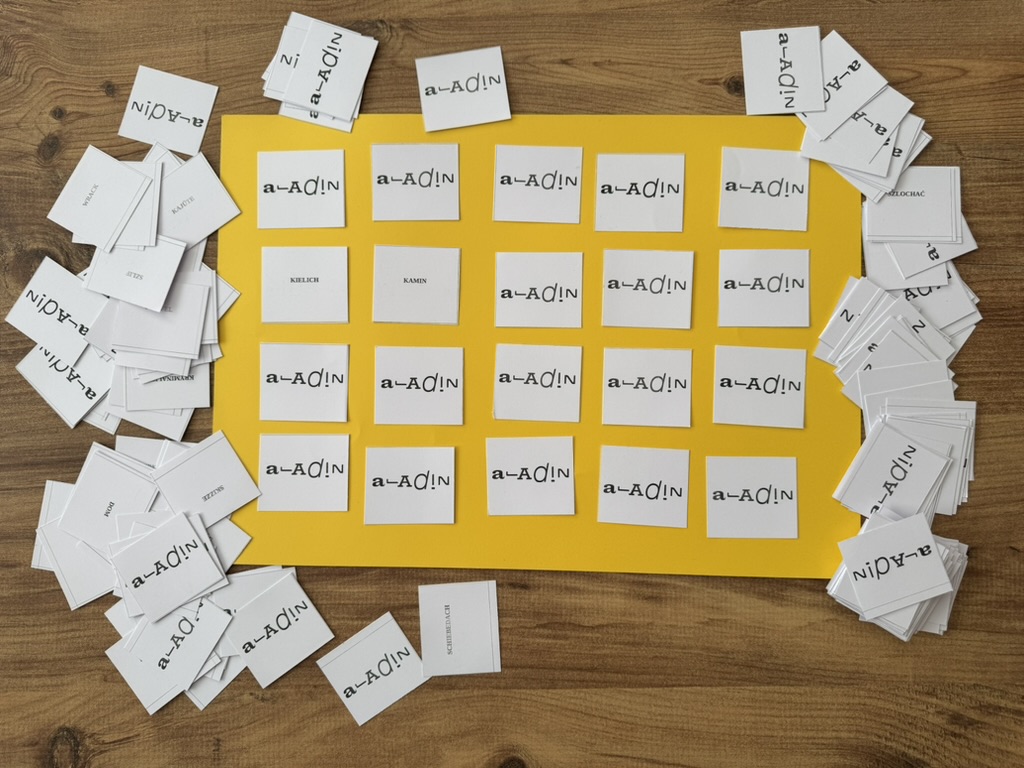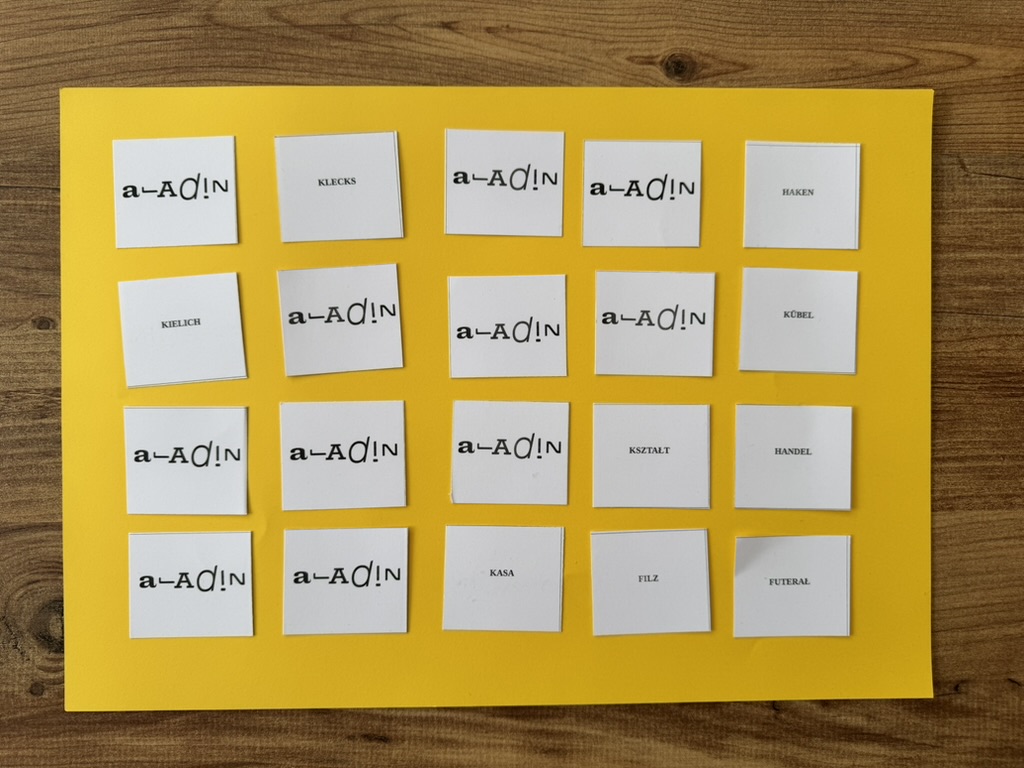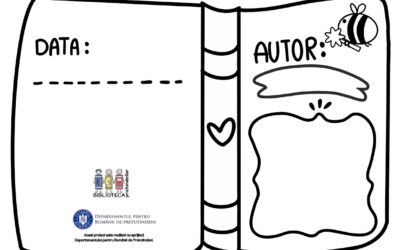True and False Friends – a Memory Game
With this game, learners not only improve their vocabulary, avoiding lexical pitfalls while also benefitting from existing knowledge of the majority language. They also playfully gain a better understanding of the historical and cultural ties that link their heritage language to the majority language.
True and False Friends – a Memory Game
30-45 min
7 or above
Language Skills
B1 or above
up to 20 ppl (in small groups)
This activity helps participants expand their vocabulary in Polish and German by playing a memory game with word pairs that look or sound similar but have different meanings (false friends) or shared meanings (true friends). While having fun, players improve their concentration, discover interesting language connections, and sharpen their memory and strategic thinking. It also raises awareness of how languages influence each other and deepens cross-linguistic understanding.
a set of memory cards with Polish or German words printed on one side.

Languages Available
1. Preparation of the memory cards:
Create a set of memory cards with Polish-German word pairs that are written or pronounced the same way or similarly but have a completelydifferent meaning – ‘false friends’ or (at least) one similar meaning – ‘true friends’. Use uppercase letters to avoid issues of different spelling– nouns are spelled with an initial uppercase letter in German but not in Polish – and the same pattern of the reverse side. For this, you caneither use the template available on the ALADIN project website or create your own memory game (see Online resources). In the latter case,avoid rare words or those that are no longer in use, as well as highly technical terms. The participants should be able to recognise the wordsand their meanings. Be aware that loanwords from Polish are few in German (e.g. granica / Grenze /border, szabla / Säbel / saber, twaróg /Quark / a sort of cottage cheese, ogórek / Gurke / cucumber) and often no longer recognised as such, while there are several thousands ofGerman loanwords in Polish, similarly often no longer recognised, ranging from rathusz / Rathaus / town hall and burmistrz / Bürgermeister /mayor to the recent autohaus / Autohaus / car dealership and szyberdach / Schiebedach / sliding roof of a car.
If you create a bigger card set you’ll be able to better adapt your selection to your target group or to play the game later again with differentword pairs. The number and difficulty of the word pairs affect the duration of the game and should bed determined according to theparticipants’ profile, for instance 20–30 cards for children of 6 to 8 years old for a duration of 10 to 20 minutes, 30–50 cards for those aged9 to 12 (15–30 min) and 50–75 cards for teenagers and adults (25–45 min), who are able to develop gaming strategies.
2. The rules of the game:
‘True and False Friends’ is played like any memory game. Place the selected cards face down on the table. Players then in turn uncover two cards.
If they think the pair forms a match, that is are true or false friends, ask them to explain or paraphrase the meaning of the words and confirm, or invalidate, their guess. If successful, a player puts the two cards next to him, before being allowed to guess once more. If not, it is up to the next
player to try his luck and test his memory. The game ends when all word pairs have been correctly identified. In a competitive game, the winner is the player with the highest number of cards.
3. Playing the game:
Lay all cards face down on the table, explain the rules of the game and then open it. Before announcing your decision whether a player has guessed right or not, consider asking the other players or add a short explanation on the meaning and usage of a word (see below) if the correct pairing seems difficult for the participants. After the game, ask the players which word pairs have been particularly hard to identify and obtain some feedback to better select your cards in future. If you don’t decide to run the game as a competition, its duration will likely be longer.
4. Additional explanations or activities (optional):
For elder children, teenagers and adults who are familiar with Poland’s history, you can close the came with a short lesson. Explain, for example,why the Polish language has more loanwords from German than vice versa and during which historical periods these were more frequent, such asthe Middle Ages (christianisation from West to East, settlement of German-speaking peasants and traders on Polish territories), after Poland’spartition in the late 18 century (when Prussia and the Habsburg Epire were occupying Polish territories), during World War II and after 1990and the fall of communism, or less frequent , such as during the Polish-Lithuanian Commonwealth and after the refoundation of the Polish State.It is also possible to illustrate how loanwords have been adopted. Thus, the Polish word ‘szlafmyca’ was borrowed around 1793 from the German‘Schlafmütze’ (night cap), at a time when people frequently wore such a cap during sleep – as the wolf in the fairy tale Little Red Riding Hood –to protect their head against the cold, their hair cut or the pillow from hair oil. In German, the word has another meaning, which does not exist inPolish, and also designates a ‘sleepy’ person, someone who reacts slowly, lacks attention, is lazy or simply sleeps a lot, thus becoming apotential ‘false friend’ for Polish heritage speakers living in Germany. If a word has been borrowed in both languages from a third language, suchas Latin, their meaning(s) may have developped differently. Thus, ‘konkurs’, from Latin ‘concurrere’ / ‘run ’ or ‘meet together’, has in Polish thesense of a sports ‘race’ or ‘competition’, while in German it refers to an insolvent business – orginally its creditors were coming together.Similarly, a Polish ‘kollega’ is a ‘friend’ or ‘acquaintance’ whereas a German ‘Kollege’ is a colleague at work.
You can also ask participants to write a short text with true and false friends, such as the one below on page 7, or to draw a comic-like scenethat illustrates a misunderstanding between two people through one or more false friends.

For Educators & Teachers
Preparation
-
Print out the template and cut the print-out into cards or create your own memory game.
-
If necessary, prepare a cheat sheet with short explanations on the meaning, usage or history of the words used in the game.
-
If appropriate, select word pairs that can be recognised by your target group.
-
If appropriate, gather illustrations of animals or prepare templates of animal silhouettes.
-
If you add a short lesson, you may want to prepare a short presentation.
Expected output
- Learners practise or discover new vocabulary and potentially improve their spelling competence.
- New vocabulary is better memorised through the accompanying gaming activity.
- Participants learn more about the history of the two languages and loanwords in the heritage language.
- Improved concentration, persistence and communicative competence.
Adaptation/Application of the method
a group with varied language proficiency
The workshop can be held in the heritage or the majority language with elements of the former, depending on proficiency levels. If these vary considerably, consider letting participants work in tandems or small groups.
other languages
True and false friends exist between many language pairs, such as Arabic and European languages, but there should be a sufficient number of them.
bilingual/multilingual options
The activity can be adapted to multilingual settings, if there exist enough common loanwords. In thisr case, emphasis should be put on comparing vocabulary across several languages.
cultural context
True and false friends exist in many heritage languages but the borrowing is often language-specific.
other age groups
– For younger children, it is possible to use illustrations instead of printed words, such as those of a cathedral and a house for the word pair ‘DOM’.
– The number of cards should also be reduced in this case. The players are in any case required to have a sufficiently large vocabulary.
outdoor version
The activity can take place outdoors, at a table in a garden or park, under favourable weather conditions.
distance-learning option
– In principle, it is possible to create a digital version of the game with simple coding skills (e.g. JavaScript). It is possible that suchversions are already available and offered as part of online language courses.
– However, playing the game online leads to a loss of interaction between players and is therefore of less paedagogical value.
challenges
– Participants with low proficiency levels in the heritage language may have to work with a much reduced vocabulary but can have recourse to adictionary to identify relevant words and phrases.
– To avoid difficultes less advanced learners in a group with different language proficiency levels, pair them with more proficient heritagespeakers and favour peer learning.
options for parents
– Parents who are native speakers of the heritage language can easily organise this activity for their child or children and assume the role ofthe arbiter, if they have a sufficient command of the heritage language and are able to provide short explanations with or without any priorpreparation.
– In contrast to a conventional memory game, it is essential that a linguistically competent person be present during the game.
Developed by / Origin / Original language
Katarzyna Włusek & Rupert Hasterok, Comparative Research Network e. V. – English, Polish
References, and Resources
– The most complete historical dictionary of German loanwords in Polish – until the mid-twentieth century – is the ‘Wörterbuch der deutschen Lehnwörter in der polnischen Schrift- und Standardsprache’, which can be consulted here. However, it contains many obsolete loanwords.
To look up the meanings of Polish words, consult one of the available online monolingual Polish dictionaries, such as ‘Słownik języka polskiego PWN’, which can be consulted
here.
For the meanings of German words, you may want to consult the ‘Digitales Wörterbuch der deutschen Sprache’, available online here.
A short list of ‘false friends’ in Polish and German can be found here.
You can also simply use a search engine and consult relevant articles in the Polish and German Wikipedia editions to identify appropriate words.
Photo on the opening page © Comparative Research Network e. V.
Similar Activities
Storytelling
Short description of the method
Ma première histoire
This fun activity for all ages uses storytelling and a simple card game to help children develop language skills, creativity, and self-confidence by reading, identifying story elements, and creating their own stories


